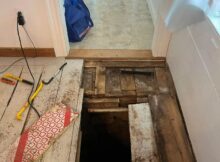Surprise Under The Floor!

During a recent renovation of an old farmhouse, a surprising find was made beneath the floorboards of the entryway. Hidden for decades, a rectangular stone-lined chamber and two 6-inch clay pipes were uncovered, sparking curiosity about its purpose. The initial hypothesis is that this structure served as a cistern, part of an old water system designed to store water, possibly fed by a nearby brook. This discovery offers an intriguing glimpse into the past and highlights the resourcefulness of homeowners in managing their water supply before modern plumbing.
Cisterns were common in the 19th century, particularly in rural areas where water supply could be unreliable. They were often constructed to collect and store rainwater or channel water from nearby sources such as brooks. In regions with sandy soil, where wells might not provide a consistent supply of water, cisterns offered a practical solution. These systems provided households with a backup water source for daily needs, including drinking, cooking, cleaning, and even small-scale irrigation.
 source: Reddit
source: Reddit
The chamber discovered beneath the farmhouse appears to fit this pattern. Its stone lining and connection to clay pipes suggest it may have been part of a larger water management system that relied on gravity to feed water into the cistern. Given the sandy soil surrounding the home, the need for such a system becomes even more plausible, as wells in the area may have struggled to provide a reliable water supply year-round.
The two clay pipes discovered leading into the corner of the room are key clues to understanding the structure’s function. Clay pipes were widely used in the 19th and early 20th centuries for water transport and drainage, known for their durability and resistance to corrosion. The placement of the pipes suggests they were intended to channel water into the cistern, possibly from the brook or a rainwater collection system on the property.
 source: Reddit
source: Reddit
Further investigation is required to fully understand the cistern’s history and function. Tracing the clay pipes could reveal whether they once connected to an external water source, such as the brook, or if they were part of a rainwater collection system. Additionally, examining the interior of the cistern for signs of water residue, fittings, or other remnants could provide more evidence of its original purpose.
The discovery of a hidden cistern beneath the floorboards of an old farmhouse provides an intriguing connection to the past. The structure, likely used to store water from a nearby brook or rainwater collection system, speaks to the practical solutions that early homeowners relied upon to ensure a reliable water supply. While further investigation is needed to confirm the details of the cistern’s history, this find serves as a valuable reminder of how homes and infrastructure have evolved over time.




